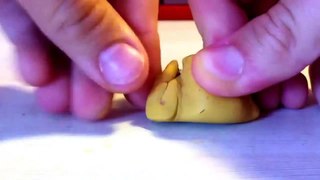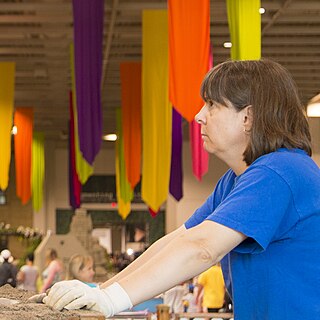
A beach is a landform alongside a body of water which consists of loose particles. The particles composing a beach are typically made from rock, such as sand, gravel, shingle, pebbles, etc., or biological sources, such as mollusc shells or coralline algae. Sediments settle in different densities and structures, depending on the local wave action and weather, creating different textures, colors and gradients or layers of material.

Singing sand, also called whistling sand, barking sand or singing dune, is sand that produces sound. The sound emission may be caused by wind passing over dunes or by walking on the sand.

Plaster is a building material used for the protective or decorative coating of walls and ceilings and for moulding and casting decorative elements. In English, "plaster" usually means a material used for the interiors of buildings, while "render" commonly refers to external applications. The term stucco refers to plasterwork that is worked in some way to produce relief decoration, rather than flat surfaces.

Sandpaper, also known as glasspaper or as coated abrasive, is a type of material that consists of sheets of paper or cloth with an abrasive substance glued to one face. In the modern manufacture of these products, sand and glass have been replaced by other abrasives such as aluminium oxide or silicon carbide. It is common to use the name of the abrasive when describing the paper, e.g. "aluminium oxide paper", or "silicon carbide paper".

Fimo is a brand of polymer clay made by German company Staedtler. Fimo is sold worldwide. Its main U.S. competitor is the American brand Sculpey. The material comes in many different colors; there are many finishes to choose from, and even a softener to use with it because it can be hard to work. It is used for making many objects, including jewelry, accessories, and small ornaments. Once shaped, Fimo is baked in a standard or toaster oven for about 30 minutes at 130 °C (265 °F) to harden it. Once baked, it can be cut, drilled, painted, sanded, and sliced thinly. According to information from Staedtler, Fimo contains polyvinyl chloride (PVC), but has not contained any phthalates since 2006.

Sandpainting is the art of pouring coloured sands, and powdered pigments from minerals or crystals, or pigments from other natural or synthetic sources onto a surface to make a fixed or unfixed sand painting. Unfixed sand paintings have a long established cultural history in numerous social groupings around the globe, and are often temporary, ritual paintings prepared for religious or healing ceremonies. This form of art is also referred to as drypainting.
This page describe terms and jargon related to sculpture and sculpting.

Hydrophobic sand is a toy made from sand coated with a hydrophobic compound. The presence of the hydrophobic compound causes the grains of sand to adhere to one another and form cylinders when exposed to water, and form a pocket of air around the sand. The pocket of air makes magic sand unable to get wet. A variation of this, kinetic sand, has several of the same properties, but acts like wet sand that will not dry out. Hydrophobic sand, whether the wet or dry type, will not mix with water.

Sand festivals or festivals of sand sculpture are exhibitions of sculptures made of sand carried out in various places around the world. These events usually include a competition.

Powder glass beads are a type of necklace ornamentation. The earliest such beads were discovered during archaeological excavations at Mapungubwe in South Africa, and dated to between 970-1000 CE. Manufacturing of the powder glass beads is now concentrated in West Africa, particularly in the Ghana area. The origins of beadmaking in Ghana are unknown, but the great majority of powder glass beads produced today is made by Ashanti and Krobo craftsmen and women. Krobo bead making has been documented to date from as early as the 1920s but despite limited archaeological evidence, it is believed that Ghanaian powder glass bead making dates further back. Bead making in Ghana was first documented by John Barbot in 1746. Beads still play important roles in Krobo society, be it in rituals of birth, coming of age, marriage, or death.

A sand cleaning machine, beach cleaner, or (colloquially) sandboni is a vehicle that drags a raking or sifting device over beach sand to remove rubbish and other foreign matter. They are manually self-pulled vehicles on tracks or wheels or pulled by quad-bike or tractor. Seaside cities use beach cleaning machines to combat the problems of litter left by beach patrons and other pollution washed up on their shores. A chief task in beach cleaning strategies is finding the best way to handle waste matter on the beaches, taking into consideration beach erosion and changing terrain. Beach cleaning machines work by collecting sand by way of a scoop or drag mechanism and then raking or sifting anything large enough to be considered foreign matter, including sticks, stones, litter and other items.

Leather crafting or simply leathercraft is the practice of making leather into craft objects or works of art, using shaping techniques, coloring techniques or both.

Glass casting is the process in which glass objects are cast by directing molten glass into a mould where it solidifies. The technique has been used since the 15th century BCE in both Ancient Egypt and Mesopotamia. Modern cast glass is formed by a variety of processes such as kiln casting or casting into sand, graphite or metal moulds.

Sand is a granular material composed of finely divided mineral particles. Sand has various compositions but is defined by its grain size. Sand grains are smaller than gravel and coarser than silt. Sand can also refer to a textural class of soil or soil type; i.e., a soil containing more than 85 percent sand-sized particles by mass.
The U.S. Open Sandcastle Competition was the largest sandcastle competition in the United States and among the top 10 best sandcastle competitions, according to the Travel Channel. The U.S. Open Sandcastle Competition was an annual, free summer weekend event held in Imperial Beach, California and was open to the public.

Granulation is the process of forming grains or granules from a powdery or solid substance, producing a granular material. It is applied in several technological processes in the chemical and pharmaceutical industries. Typically, granulation involves agglomeration of fine particles into larger granules, typically of size range between 0.2 and 4.0 mm depending on their subsequent use. Less commonly, it involves shredding or grinding solid material into finer granules or pellets.

Phragmatopoma californica, commonly known as the sandcastle worm, the honeycomb worm or the honeycomb tube worm, is a reef-forming marine polychaete worm belonging to the family Sabellarididae. It is dark brown in color with a crown of lavender tentacles and has a length of up to about 7.5 centimeters (3.0 in). The worm inhabits the Californian coast, from Sonoma County to northern Baja California.

Sudarsan Pattnaik is an Indian sand artist from Puri, Odisha. In 2014, the Government of India honoured him with the Padma Shri, India's fourth-highest civilian award, for his seashore sand arts.
Hat Chom Dao or Kaeng Chom Dao is a Thai tourist attraction. It sits on the Mekong River in Tambon Na Tan, Na Tan District, Ubon Ratchathani Province, Thailand. It is a rock formation, which is overtopped by the river during high tide but becomes accessible during the dry season. Tourists are attracted by the area because of its beautiful shape. Many surf in the Mekong during the wet season. Highlights include sunrise and sunset views, as well as stargazing at night. During the dry season beach is white fine sand grains a width of about 2 km. Beaches are only visible during the winter or low tide.

Karen Fralich is a Canadian artist known for sand sculpting. Based in Guelph, Ontario, she is a five-time sand sculpting world champion and has been a judge on the reality television show Race Against the Tide since 2021.
































